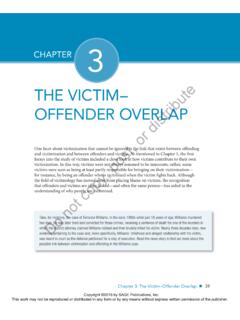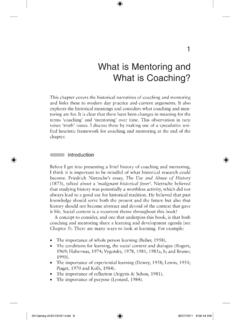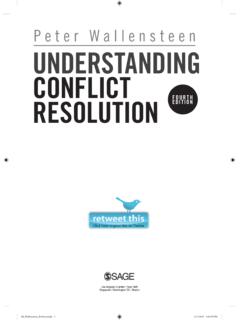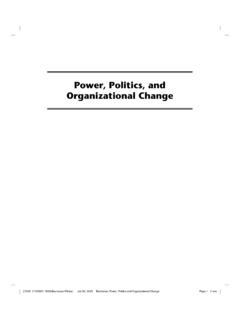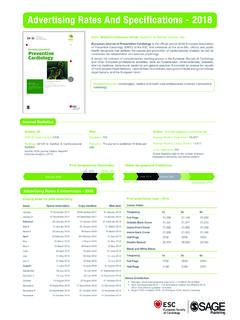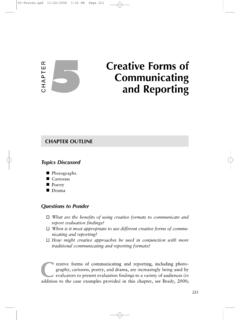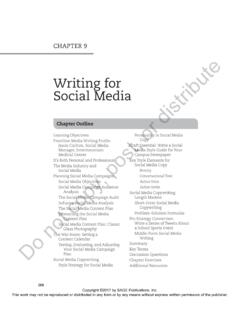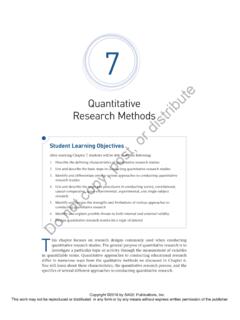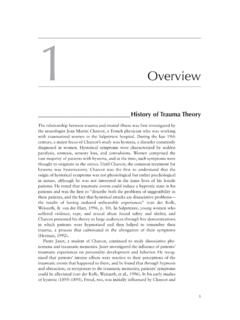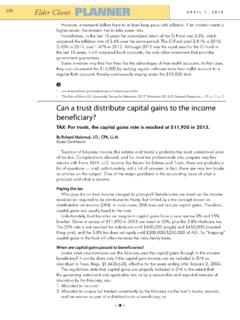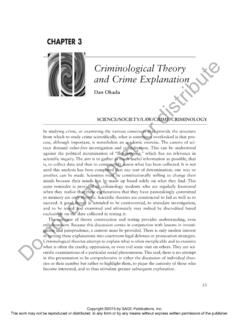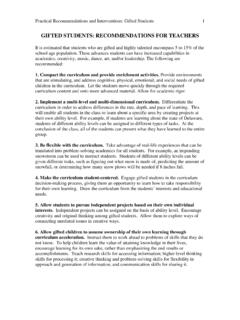Transcription of CHAPTER CONCEPTUAL FRAMEWORKS IN RESEARCH distribute
1 32 CHAPTER TWOCHAPTER OVERVIEW AND GOALSIn this CHAPTER , we emphasize the importance of CONCEPTUAL FRAMEWORKS in RESEARCH and discuss the central role they play in all aspects of qualitative RESEARCH . This CHAPTER begins with a discussion of what constitutes a CONCEPTUAL framework . After establishing a working sense of what a CONCEPTUAL framework is and a beginning roadmap of its uses, we focus on what it does or, more precisely, what you do with it. Following this, we discuss how to construct a CONCEPTUAL framework and provide recommended practices to help you develop one.
2 We also include an example CONCEPTUAL framework memo that details how a researcher describes their CONCEPTUAL FRAMEWORKS IN RESEARCHA CONCEPTUAL framework lives at the center of an empirical study. The CONCEPTUAL framework serves as a guide and ballast to RESEARCH (Ravitch & Riggan, 2016), functioning as an integrating ecosystem that helps researchers intentionally bring all aspects of a study together through a process that explicates their connec-tions, disjunctures, overlaps, tensions, and the contexts shaping a RESEARCH setting and the study of phenomena in that setting.
3 As a qualitative researcher, it is vital to understand what a CONCEPTUAL framework is, what its component parts are and how they inter-act, and how it is used to guide high-quality, rigorous qualitative the end of this CHAPTER you will better understand The roles and uses of a CONCEPTUAL framework How to construct your own CONCEPTUAL framework How a CONCEPTUAL framework guides and grounds empirical RESEARCH How you use a CONCEPTUAL framework to build and refine your study The relationship between a CONCEPTUAL and theoretical framework The difference between a literature review and a theoretical framework Each of the component parts of a CONCEPTUAL framework and how they fit together The multiple
4 Possibilities for developing and representing CONCEPTUAL FRAMEWORKS in narrative and graphic formCONCEPTUAL FRAMEWORKS IN RESEARCHC opyright 2021 by SAGE Publications, Inc. This work may not be reproduced or distributed in any form or by any means without express written permission of the not copy, post, or distributeCHAPTER 2 CONCEPTUAL FRAMEWORKS in RESEARCH 33 What Is a CONCEPTUAL framework ? CONCEPTUAL FRAMEWORKS have historically been a somewhat confusing aspect of quali-tative RESEARCH design. Relatively little has been written about them, and various terms, including CONCEPTUAL framework , theoretical framework , theory, idea context, logic model, and concept maps, are used somewhat interchangeably and often in unclear ways.
5 Reason and Rigor, by Ravitch and Riggan (2012, 2016), emerged as a response to this CONCEPTUAL and definitional murkiness; it focuses on articulating what comprises a CONCEPTUAL frame-work and how CONCEPTUAL FRAMEWORKS guide RESEARCH from its inception to its comple-tion. Because that book goes into great detail about how a CONCEPTUAL framework is used in actual studies (with multiple empirical studies used to exemplify its role at various stages of the RESEARCH process), it is the best current source for seeing how the CONCEPTUAL framework guides every facet of RESEARCH .
6 In this CHAPTER , we build on that text and the work it builds on and seek to conceptualize the term and highlight the roles and uses of the CONCEPTUAL framework , as well as the process of developing one, since a CONCEPTUAL framework is a generative source of thinking, planning, conscious action, and reflection throughout the RESEARCH CONCEPTUAL framework makes the case for why a study is significant and relevant and for how the study design (including data collection and analysis methods) appropri-ately and rigorously answers the RESEARCH questions.
7 In addition, a CONCEPTUAL framework situates a study within multiple contexts, including the overall methodological approach you work from ( , critical race theory, poststructuralist theory, feminist theory, new materialist theory, queer theory) and how you, as the researcher, are located in relation to the RESEARCH (Ravitch & Riggan, 2016). The CONCEPTUAL framework consists of mul-tiple parts and serves a variety of intersecting and ongoing functions for researchers embarking on and engaging in RESEARCH and the scholarship it produces. As Figure illustrates, a CONCEPTUAL framework includes multiple components that intersect, inform, and influence each other.
8 For example, the methods that you use to answer your RESEARCH questions are informed (in conscious and unconscious ways) by your tacit theories, theoretical framework , the personal and professional goals of your study, ways that you systematically reflect on multiple aspects of your RESEARCH (structured reflexivity), the intentional interactions you have with others (dialogic engagement),1 the macro and micro contexts of the RESEARCH setting, and you (as the researcher), including your social identity and positionality (including the macro contexts of the RESEARCH ).
9 Throughout this CHAPTER , we describe these components and how they come together to form your CONCEPTUAL framework so that it serves as the integrating ecosystem of your empirical of a CONCEPTUAL FrameworkAs noted above, the roles of a CONCEPTUAL framework include arguing for the significance of a topic, grounding the topic in its multiple contexts (theoretical and actual), guid-ing the development and iteration of RESEARCH questions, the selection of theories and methods within a methodological framework that makes sense for the topic and allows for rigor, and providing you, as the researcher, with a framework and set of contexts in Copyright 2021 by SAGE Publications, Inc.
10 This work may not be reproduced or distributed in any form or by any means without express written permission of the not copy, post, or distribute34 QUALITATIVE RESEARCH which you can examine your social identity and positionality as they relate to and shape the RESEARCH processes, including overall methodology and specific methods CONCEPTUAL framework creates a bridge between the context, theory (both for-mal and tacit), and the way the study is structured in relation to all of these contextualiz-ing and mediating influences.
